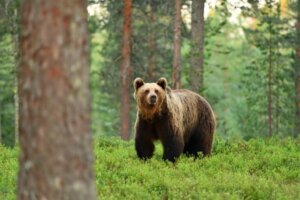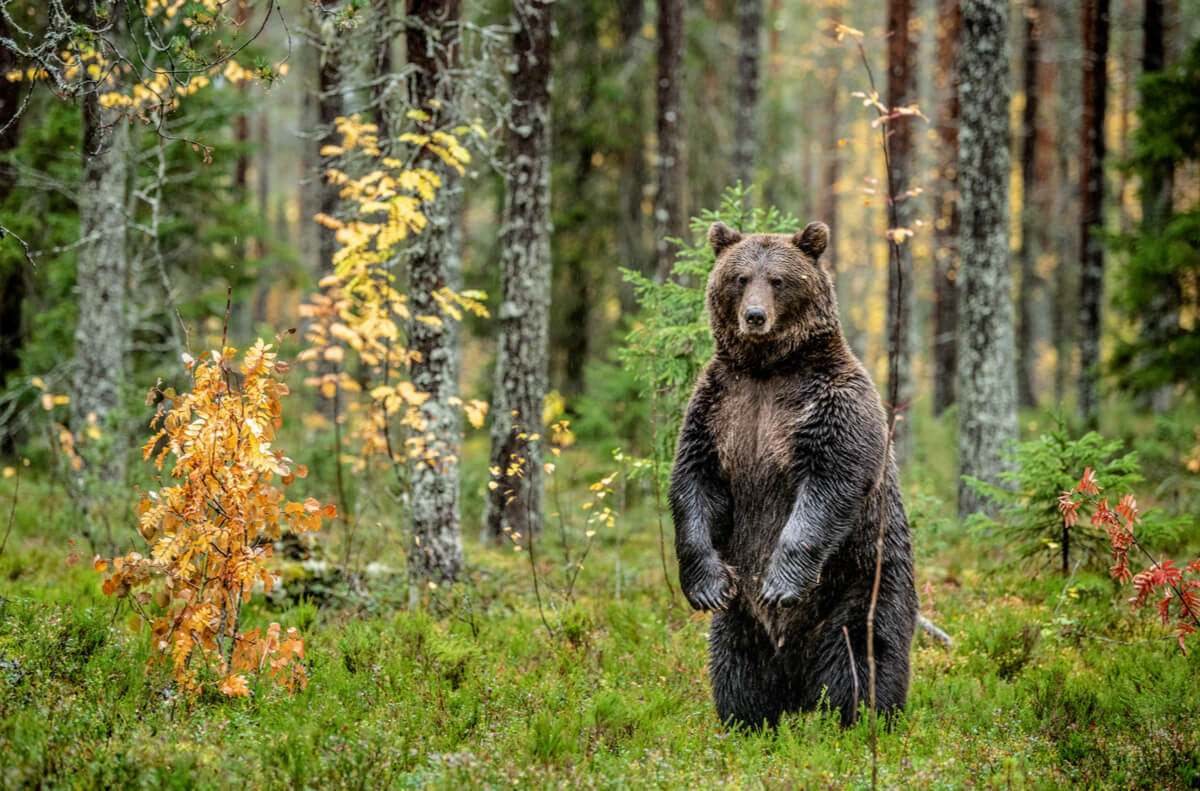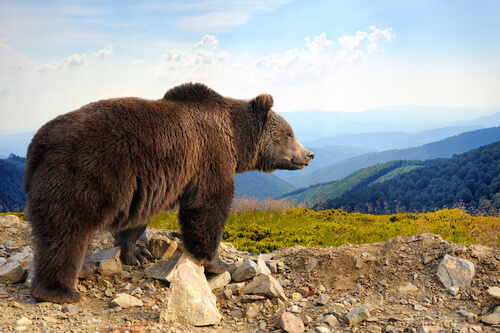9 Curiosities About Brown Bears


Written and verified by the biologist Georgelin Espinoza Medina
There are many different hunters in the animal kingdom, right at the top of the food chain and with very few animals capable of challenging them. Bears are one of them. Majestic and imposing mammals, very large, and ferocious too. Here are some curiosities about brown bears – see if you knew any of them!
Brown bears have the scientific name Ursus arctos and are part of the Ursidae family. They’re widely distributed in the forests of northern Asia, Europe, and America. If you want to know more about these colossal creatures, you’ve come to the right place, because here are 9 interesting aspects of their lives that will fascinate you!
What do brown bears look like?
As their name suggests, brown bears have brown fur, but individuals vary in shades. Generally, they have lighter noses and darker paws. Their head is broad, their snout prominent, and their ears are small. They have short tails and 5 toes on each limb, with non-retractable claws.
In these bears, we can see sexual dimorphism, which means that females and males are different in some aspects, and, in this case, we’re talking about body mass. Males are more robust than females. In general, their weight varies between 100 and 675 kilograms (220 to 1500 pounds) and they can reach almost 3 meters (9.8 feet) in length, depending on the specimen.

Curiosities about brown bears
There are several interesting facts about the life of these bears, and here are 9 of them.
1. There are 16 subspecies
Although there’s only one species of brown bear and we often think they’re all the same, the truth is that there’s a fair amount of variability according to where they live. Therefore, 16 subspecies of brown bears are currently accepted, each with defining characteristics, as they can vary in size, body mass, and some physical aspects.
2. They’re plantigrade animals
Brown bears have a plantigrade gait, which means that they use the entire area of the foot to walk. This characteristic is shared with humans and animals such as rodents, rabbits, kangaroos, raccoons, and koalas, among others. This form of displacement also allows them to stand up on their legs or hind limbs.
3. They include a large number of plants in their diet
Despite their size and ferocity, brown bears are omnivorous animals, and eat mostly vegetables, especially in the spring and autumn. In some areas, their diet may be up to 90% plant-based. Their diet includes grasses and other herbaceous plants. They also eat roots and fruits, both dry (hazelnuts, acorns) and fleshy (apples, blackberries, blueberries, cherries).
However, their dietary repertoire is very diverse. They’re also good hunters and are on the lookout for certain mammals. In addition, they can consume insects and carrion. Another of their known culinary tastes is their predilection for salmon, in some regions where these fish migrate. This food provides a high protein intake to their body, with almost no effort required.
4. They hibernate
Another of the curiosities about brown bears is their hibernation. They do this due to the scarcity of food in the winter season. They go into a deep sleep for about 5 or 6 months. During this period, they reduce their metabolism, which they achieve thanks to their physiological adaptations.
Prior to winter dormancy, brown bears go through a period of hyperphagia, that is, they ingest a greater amount of food in order to have the necessary nutritional reserves. During this period they can increase their weight by up to 70 %.
Brown bears consume grass and soil, along with food, before hibernation. The purpose of this is to form a kind of bolus, which clogs the intestine during this time. Thus, digestion becomes slower and every nutrient is used.
5. They consume up to 40 kilograms of food per day
As expected, thanks to their size, brown bears need to eat large amounts of food per day, particularly before going into hibernation. They can consume up to 40 kilograms, and achieve this due to the great variability of food they can eat – an impressive fact about these mammals.
6. Bears have cubs every 2 or 3 years
One of the curiosities about brown bears regards reproduction. They carry their cubs in their wombs, which requires extra energy expenditure and poses a greater challenge for their survival due to hibernation.
In this scenario, bears can take up to 2 or 3 years before they have offspring again. They have their cubs during the winter, nurse them and provide warmth, which adds more energy expenditure for them. In addition, parental care is extended for two and a half years. This shows the hard work these amazing warriors have.
7. They’re polygamous animals
Like all mammals, they’re characterized by how they reproduce sexually. They’re polygamous, which means that they don’t only have one partner. There are even cases of multiple paternities in the same litter, which can range from 1 to 4 offspring, a surprising fact.
8. They have poor vision
These ursids are characterized by the fact that they don’t see very well. However, they rely on other senses that are more developed, such as hearing and smell. In this way, they’re able to carry out their foraging activities, another curious fact about brown bears.
9. They’re threatened with extinction in some regions
Although the global conservation status of bears is of lesser concern, according to the International Union for Conservation of Nature, in some areas the situation is more critical. In the Mediterranean region, for example, the species is classified as vulnerable. The main threats involve poaching, isolation of populations, and habitat alteration, among others.

Our curiosities about brown bears have shown us some interesting and amazing aspects of these ferocious creatures that you may not have known about. They’re animals that use the resources available to them in their surroundings, and adapt their metabolism in the winter during their struggle for survival.
There are many different hunters in the animal kingdom, right at the top of the food chain and with very few animals capable of challenging them. Bears are one of them. Majestic and imposing mammals, very large, and ferocious too. Here are some curiosities about brown bears – see if you knew any of them!
Brown bears have the scientific name Ursus arctos and are part of the Ursidae family. They’re widely distributed in the forests of northern Asia, Europe, and America. If you want to know more about these colossal creatures, you’ve come to the right place, because here are 9 interesting aspects of their lives that will fascinate you!
What do brown bears look like?
As their name suggests, brown bears have brown fur, but individuals vary in shades. Generally, they have lighter noses and darker paws. Their head is broad, their snout prominent, and their ears are small. They have short tails and 5 toes on each limb, with non-retractable claws.
In these bears, we can see sexual dimorphism, which means that females and males are different in some aspects, and, in this case, we’re talking about body mass. Males are more robust than females. In general, their weight varies between 100 and 675 kilograms (220 to 1500 pounds) and they can reach almost 3 meters (9.8 feet) in length, depending on the specimen.

Curiosities about brown bears
There are several interesting facts about the life of these bears, and here are 9 of them.
1. There are 16 subspecies
Although there’s only one species of brown bear and we often think they’re all the same, the truth is that there’s a fair amount of variability according to where they live. Therefore, 16 subspecies of brown bears are currently accepted, each with defining characteristics, as they can vary in size, body mass, and some physical aspects.
2. They’re plantigrade animals
Brown bears have a plantigrade gait, which means that they use the entire area of the foot to walk. This characteristic is shared with humans and animals such as rodents, rabbits, kangaroos, raccoons, and koalas, among others. This form of displacement also allows them to stand up on their legs or hind limbs.
3. They include a large number of plants in their diet
Despite their size and ferocity, brown bears are omnivorous animals, and eat mostly vegetables, especially in the spring and autumn. In some areas, their diet may be up to 90% plant-based. Their diet includes grasses and other herbaceous plants. They also eat roots and fruits, both dry (hazelnuts, acorns) and fleshy (apples, blackberries, blueberries, cherries).
However, their dietary repertoire is very diverse. They’re also good hunters and are on the lookout for certain mammals. In addition, they can consume insects and carrion. Another of their known culinary tastes is their predilection for salmon, in some regions where these fish migrate. This food provides a high protein intake to their body, with almost no effort required.
4. They hibernate
Another of the curiosities about brown bears is their hibernation. They do this due to the scarcity of food in the winter season. They go into a deep sleep for about 5 or 6 months. During this period, they reduce their metabolism, which they achieve thanks to their physiological adaptations.
Prior to winter dormancy, brown bears go through a period of hyperphagia, that is, they ingest a greater amount of food in order to have the necessary nutritional reserves. During this period they can increase their weight by up to 70 %.
Brown bears consume grass and soil, along with food, before hibernation. The purpose of this is to form a kind of bolus, which clogs the intestine during this time. Thus, digestion becomes slower and every nutrient is used.
5. They consume up to 40 kilograms of food per day
As expected, thanks to their size, brown bears need to eat large amounts of food per day, particularly before going into hibernation. They can consume up to 40 kilograms, and achieve this due to the great variability of food they can eat – an impressive fact about these mammals.
6. Bears have cubs every 2 or 3 years
One of the curiosities about brown bears regards reproduction. They carry their cubs in their wombs, which requires extra energy expenditure and poses a greater challenge for their survival due to hibernation.
In this scenario, bears can take up to 2 or 3 years before they have offspring again. They have their cubs during the winter, nurse them and provide warmth, which adds more energy expenditure for them. In addition, parental care is extended for two and a half years. This shows the hard work these amazing warriors have.
7. They’re polygamous animals
Like all mammals, they’re characterized by how they reproduce sexually. They’re polygamous, which means that they don’t only have one partner. There are even cases of multiple paternities in the same litter, which can range from 1 to 4 offspring, a surprising fact.
8. They have poor vision
These ursids are characterized by the fact that they don’t see very well. However, they rely on other senses that are more developed, such as hearing and smell. In this way, they’re able to carry out their foraging activities, another curious fact about brown bears.
9. They’re threatened with extinction in some regions
Although the global conservation status of bears is of lesser concern, according to the International Union for Conservation of Nature, in some areas the situation is more critical. In the Mediterranean region, for example, the species is classified as vulnerable. The main threats involve poaching, isolation of populations, and habitat alteration, among others.

Our curiosities about brown bears have shown us some interesting and amazing aspects of these ferocious creatures that you may not have known about. They’re animals that use the resources available to them in their surroundings, and adapt their metabolism in the winter during their struggle for survival.
All cited sources were thoroughly reviewed by our team to ensure their quality, reliability, currency, and validity. The bibliography of this article was considered reliable and of academic or scientific accuracy.
- McLellan, B.N., Proctor, M.F., Huber, D. & Michel, S. 2017. Ursus arctos (amended version of 2017 assessment). The IUCN Red List of Threatened Species 2017: e.T41688A121229971.
- Naves, J., & Palomero, G. (2006). Ecología de la hibernación del oso en la Cordillera Cantábrica. Recuperado el 27 de abril de 2022, disponible en: https://www.miteco.gob.es/es/biodiversidad/temas/conservacion-de-especies-amenazadas/090471228015f110_tcm30-195606.pdf
- Purroy, F. J. (2017) Oso pardo – Ursus arctos. En: Salvador, A., Barja, I. (Eds.). Enciclopedia Virtual de los Vertebrados Españoles. Museo Nacional de Ciencias Naturales, Madrid. http://www.vertebradosibericos.org/
This text is provided for informational purposes only and does not replace consultation with a professional. If in doubt, consult your specialist.








